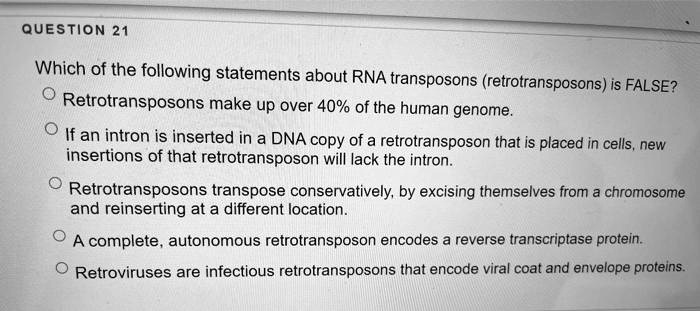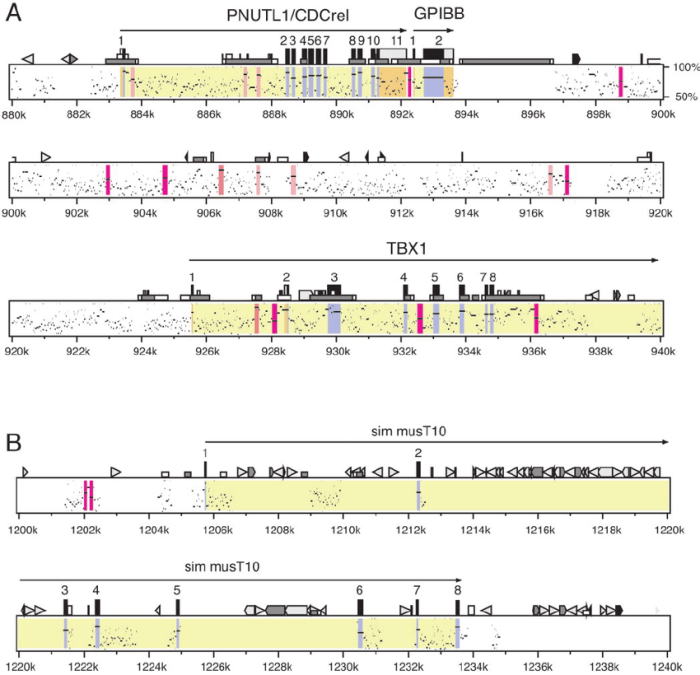Which of the following is not true of transposons? This question delves into the fascinating world of transposons, also known as “jumping genes,” exploring their unique characteristics and impact on genome evolution. Join us as we uncover the intriguing nature of these genetic elements and their role in shaping the diversity of life.
Transposons are remarkable genetic sequences capable of moving around the genome, potentially causing mutations and influencing genetic diversity. Understanding their mechanisms and distinguishing them from other genetic elements is crucial for comprehending their impact on genome evolution and their potential applications in genetic engineering.
Transposon Characteristics

Transposons, also known as transposable elements, are segments of DNA that can move within a genome. They are characterized by:
- Ability to move:Transposons can transpose or move from one location to another within the genome.
- Flanking repeats:They often have inverted or direct repeats at their ends, which facilitate their movement.
- Small size:Transposons range in size from a few hundred to several thousand base pairs.
- Autonomous vs. non-autonomous:Autonomous transposons encode proteins necessary for their movement, while non-autonomous transposons rely on proteins from autonomous transposons.
Types of transposons include:
- DNA transposons:Move directly from one site to another without an RNA intermediate.
- Retrotransposons:Transpose via an RNA intermediate, which is reverse-transcribed back into DNA.
Transposons play a significant role in genome evolution by:
- Introducing genetic diversity through insertion and deletion mutations.
- Reshuffling genes and regulatory elements, potentially altering gene expression.
- Facilitating genome rearrangements, such as inversions and duplications.
Transposon Mechanisms

Transposons move through two main mechanisms:
- Cut-and-paste:DNA transposons cut themselves out of one location and paste themselves into another, leaving a copy at the original site.
- Copy-and-paste:Retrotransposons make an RNA copy of themselves, which is then reverse-transcribed and integrated into a new location.
Transposons can cause mutations by:
- Inserting into genes, disrupting their function.
- Causing deletions or rearrangements in the genome.
Transposon activity is regulated by various mechanisms, including:
- DNA methylation:Methylation of transposon DNA can repress their activity.
- Histone modifications:Specific histone modifications can mark transposons for repression.
- RNA interference (RNAi):Small RNAs can target transposon transcripts and inhibit their translation.
Transposon Impact

Transposons have both beneficial and detrimental effects on genomes:
- Genetic diversity:Transposons contribute to genetic diversity by introducing new genetic material and shuffling existing genes.
- Genome plasticity:Transposons can facilitate genome rearrangements, providing a source of raw material for evolution.
- Disease:Transposon insertions can disrupt genes and cause genetic disorders.
- Cancer:Transposon activity has been implicated in the development of some cancers.
Transposons are also used in genetic engineering:
- Gene delivery:Transposons can be used to deliver genes into cells for therapeutic purposes.
- Genome editing:Transposons can be engineered to target specific genomic loci for gene editing applications.
Distinguishing Transposons

Transposons can be distinguished from other genetic elements by their:
- Ability to move:Transposons are the only genetic elements that can move within a genome.
- Flanking repeats:Transposons often have inverted or direct repeats at their ends, which is not typically seen in other genetic elements.
| Characteristic | Transposons | Retrotransposons | Viruses | Plasmids |
|---|---|---|---|---|
| Mobility | Yes | Yes (via RNA intermediate) | Yes | No |
| Flanking repeats | Often | Sometimes | No | No |
| Genome integration | Yes | Yes | Yes | No |
| Encapsidation | No | No | Yes | No |
| Replication | Autonomous: YesNon-autonomous: No | Yes (via reverse transcription) | Yes | Yes |
User Queries: Which Of The Following Is Not True Of Transposons
What are the defining characteristics of transposons?
Transposons are DNA sequences that can move from one location to another within the genome. They are typically flanked by short, repeated sequences and can transpose via either a “cut-and-paste” or “copy-and-paste” mechanism.
How can transposons contribute to genetic diversity?
Transposons can contribute to genetic diversity by inserting themselves into new locations within the genome. This can disrupt genes, create new regulatory elements, or even lead to the formation of new genes.
What are the potential risks of transposon activity?
Transposon activity can sometimes lead to harmful mutations, as they can disrupt genes or alter gene regulation. Additionally, transposons can contribute to genome instability, which can lead to cancer and other diseases.